Melanography Essentials - Assessment 6: Skin Cancer Pathology Report
VerifiedAdded on 2022/10/14
|9
|2202
|11
Report
AI Summary
This report delves into the pathology of skin cancer, a critical topic for melanographers. It begins with an introduction to the cellular basis of cancer, DNA's role, and the mechanisms of cancer development. The report highlights the increasing incidence of skin cancer, particularly in Australia, and differentiates between the three primary types: basal cell carcinoma, squamous cell carcinoma, and melanoma. It explores the causative agents, including UV exposure and tanning beds, and discusses the role of genetics. The report covers diagnosis through skin biopsies and staging, followed by treatment options such as surgery, radiation, and chemotherapy. Prevention strategies, including sun protection and regular skin exams, are emphasized. The relevance of this knowledge for melanographers is underscored, emphasizing the importance of understanding different skin cancer types, causes, high-risk individuals, and public education. The report concludes by summarizing the key aspects of skin cancer pathology and its implications for the field of melanography.
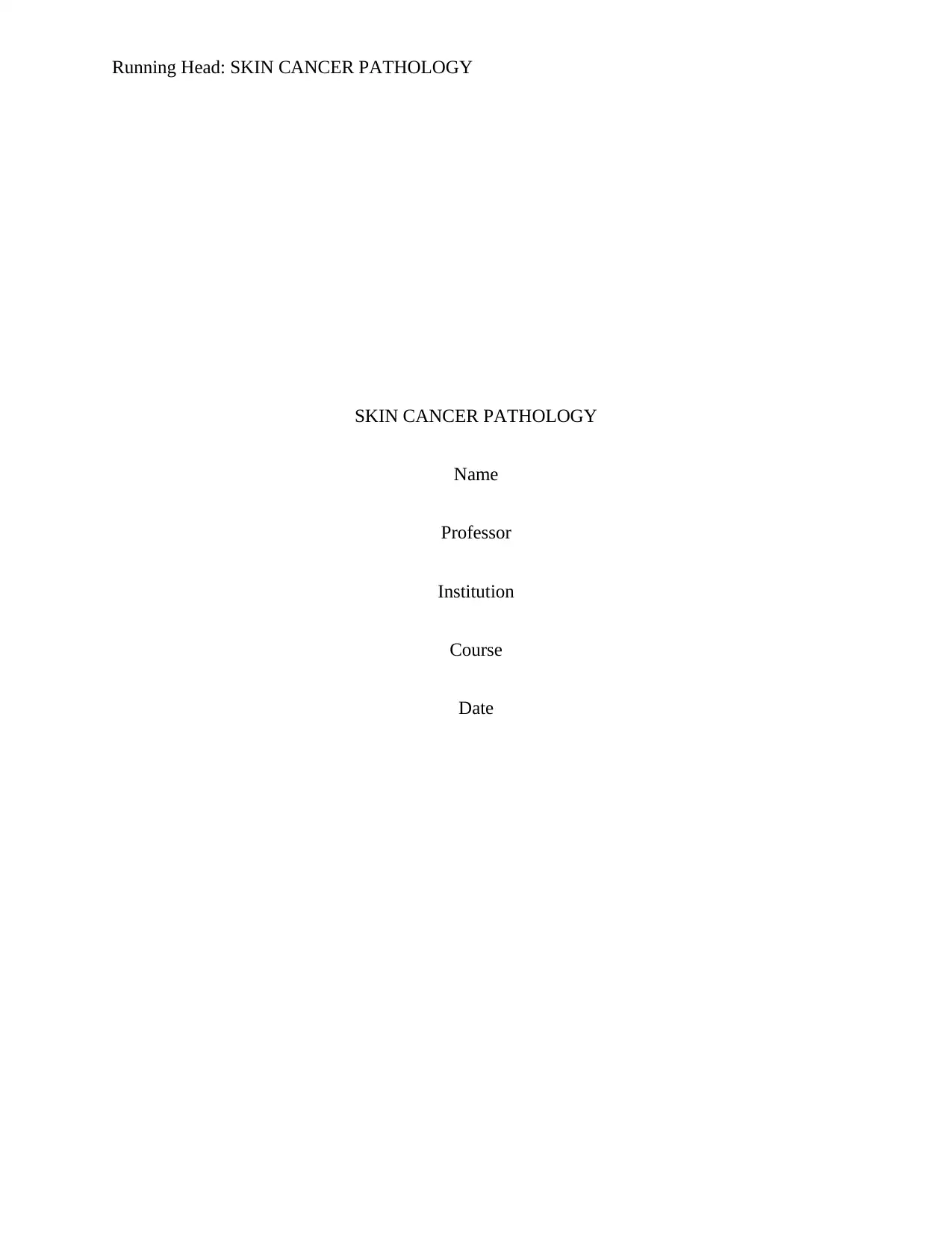
Running Head: SKIN CANCER PATHOLOGY
SKIN CANCER PATHOLOGY
Name
Professor
Institution
Course
Date
SKIN CANCER PATHOLOGY
Name
Professor
Institution
Course
Date
Paraphrase This Document
Need a fresh take? Get an instant paraphrase of this document with our AI Paraphraser
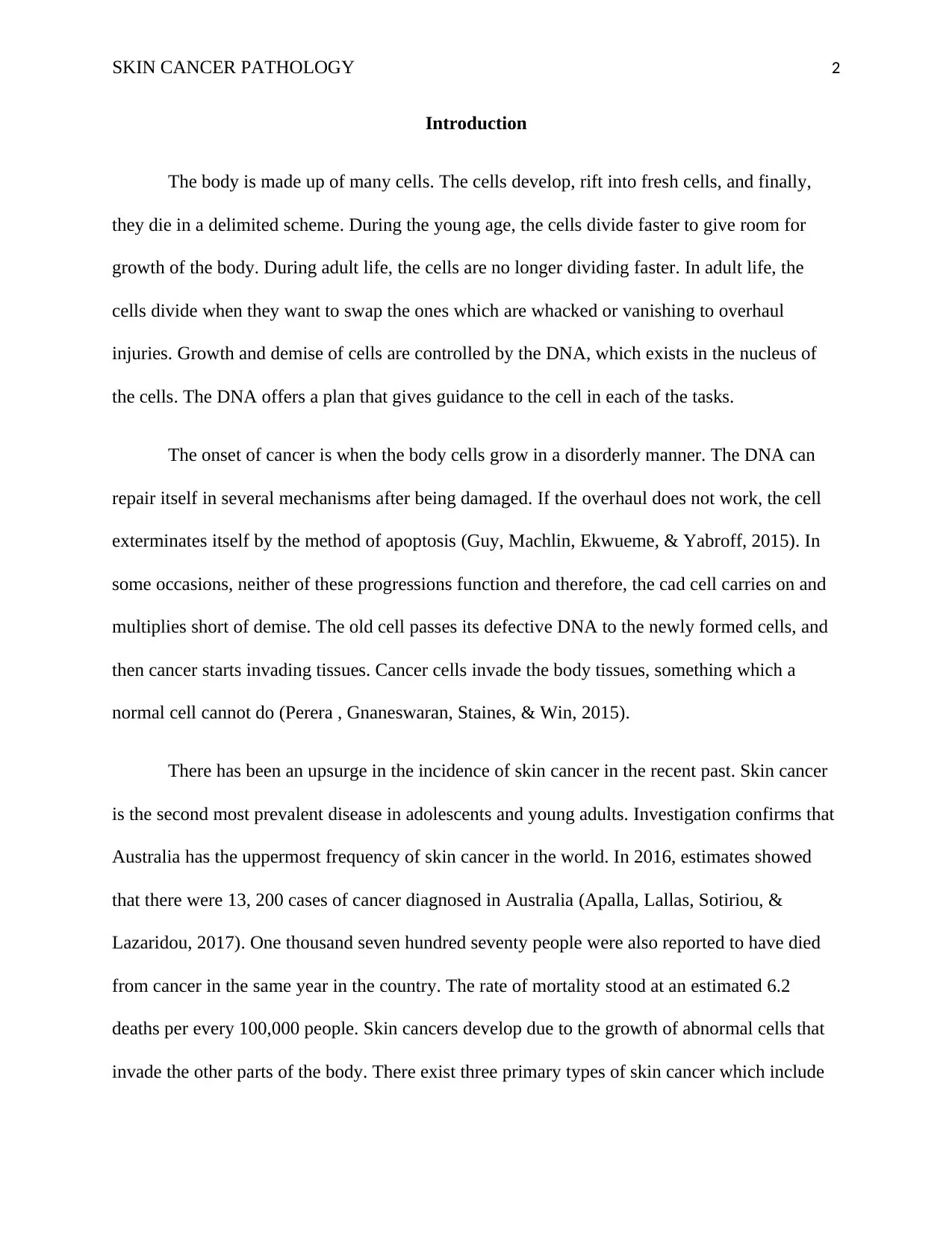
SKIN CANCER PATHOLOGY 2
Introduction
The body is made up of many cells. The cells develop, rift into fresh cells, and finally,
they die in a delimited scheme. During the young age, the cells divide faster to give room for
growth of the body. During adult life, the cells are no longer dividing faster. In adult life, the
cells divide when they want to swap the ones which are whacked or vanishing to overhaul
injuries. Growth and demise of cells are controlled by the DNA, which exists in the nucleus of
the cells. The DNA offers a plan that gives guidance to the cell in each of the tasks.
The onset of cancer is when the body cells grow in a disorderly manner. The DNA can
repair itself in several mechanisms after being damaged. If the overhaul does not work, the cell
exterminates itself by the method of apoptosis (Guy, Machlin, Ekwueme, & Yabroff, 2015). In
some occasions, neither of these progressions function and therefore, the cad cell carries on and
multiplies short of demise. The old cell passes its defective DNA to the newly formed cells, and
then cancer starts invading tissues. Cancer cells invade the body tissues, something which a
normal cell cannot do (Perera , Gnaneswaran, Staines, & Win, 2015).
There has been an upsurge in the incidence of skin cancer in the recent past. Skin cancer
is the second most prevalent disease in adolescents and young adults. Investigation confirms that
Australia has the uppermost frequency of skin cancer in the world. In 2016, estimates showed
that there were 13, 200 cases of cancer diagnosed in Australia (Apalla, Lallas, Sotiriou, &
Lazaridou, 2017). One thousand seven hundred seventy people were also reported to have died
from cancer in the same year in the country. The rate of mortality stood at an estimated 6.2
deaths per every 100,000 people. Skin cancers develop due to the growth of abnormal cells that
invade the other parts of the body. There exist three primary types of skin cancer which include
Introduction
The body is made up of many cells. The cells develop, rift into fresh cells, and finally,
they die in a delimited scheme. During the young age, the cells divide faster to give room for
growth of the body. During adult life, the cells are no longer dividing faster. In adult life, the
cells divide when they want to swap the ones which are whacked or vanishing to overhaul
injuries. Growth and demise of cells are controlled by the DNA, which exists in the nucleus of
the cells. The DNA offers a plan that gives guidance to the cell in each of the tasks.
The onset of cancer is when the body cells grow in a disorderly manner. The DNA can
repair itself in several mechanisms after being damaged. If the overhaul does not work, the cell
exterminates itself by the method of apoptosis (Guy, Machlin, Ekwueme, & Yabroff, 2015). In
some occasions, neither of these progressions function and therefore, the cad cell carries on and
multiplies short of demise. The old cell passes its defective DNA to the newly formed cells, and
then cancer starts invading tissues. Cancer cells invade the body tissues, something which a
normal cell cannot do (Perera , Gnaneswaran, Staines, & Win, 2015).
There has been an upsurge in the incidence of skin cancer in the recent past. Skin cancer
is the second most prevalent disease in adolescents and young adults. Investigation confirms that
Australia has the uppermost frequency of skin cancer in the world. In 2016, estimates showed
that there were 13, 200 cases of cancer diagnosed in Australia (Apalla, Lallas, Sotiriou, &
Lazaridou, 2017). One thousand seven hundred seventy people were also reported to have died
from cancer in the same year in the country. The rate of mortality stood at an estimated 6.2
deaths per every 100,000 people. Skin cancers develop due to the growth of abnormal cells that
invade the other parts of the body. There exist three primary types of skin cancer which include
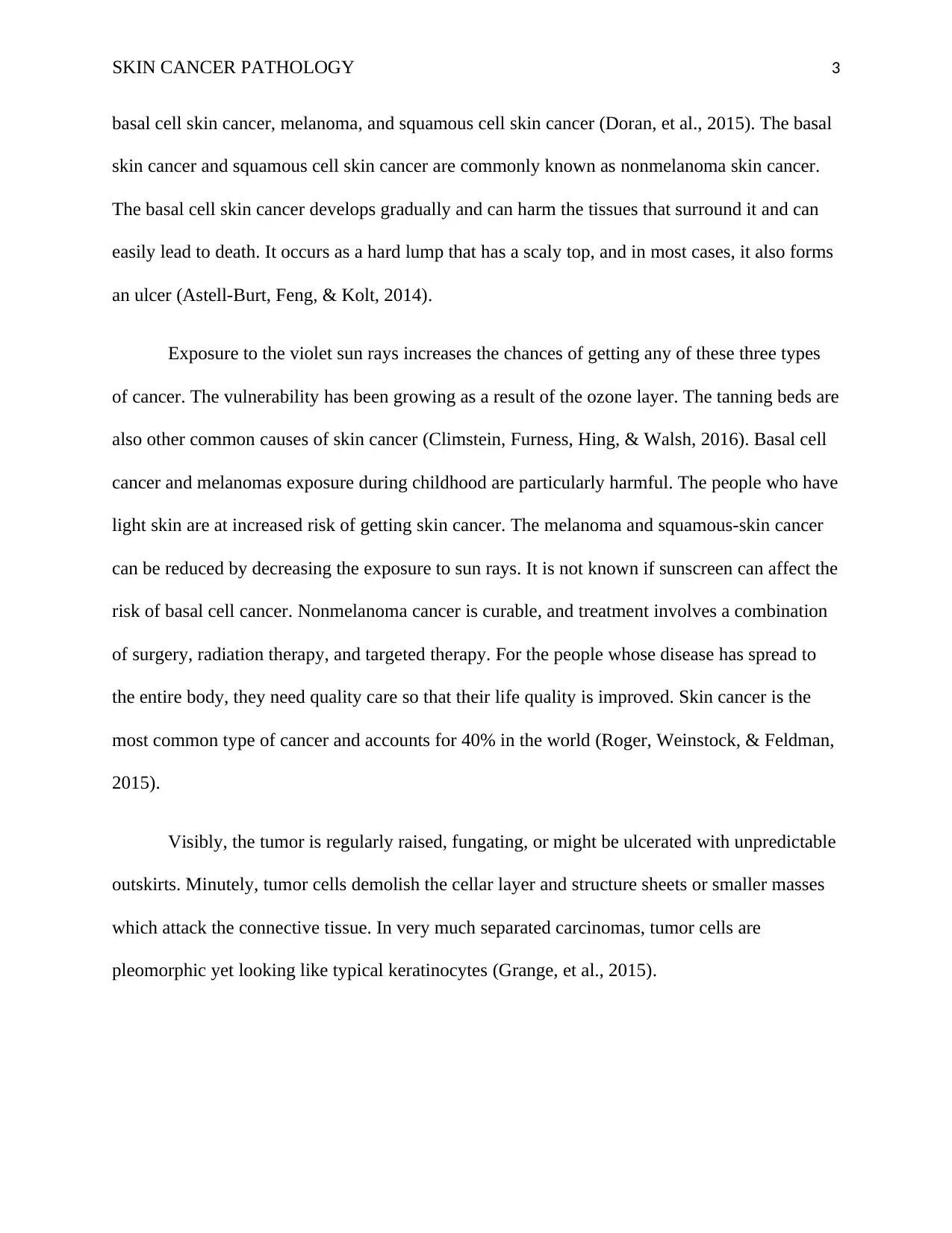
SKIN CANCER PATHOLOGY 3
basal cell skin cancer, melanoma, and squamous cell skin cancer (Doran, et al., 2015). The basal
skin cancer and squamous cell skin cancer are commonly known as nonmelanoma skin cancer.
The basal cell skin cancer develops gradually and can harm the tissues that surround it and can
easily lead to death. It occurs as a hard lump that has a scaly top, and in most cases, it also forms
an ulcer (Astell-Burt, Feng, & Kolt, 2014).
Exposure to the violet sun rays increases the chances of getting any of these three types
of cancer. The vulnerability has been growing as a result of the ozone layer. The tanning beds are
also other common causes of skin cancer (Climstein, Furness, Hing, & Walsh, 2016). Basal cell
cancer and melanomas exposure during childhood are particularly harmful. The people who have
light skin are at increased risk of getting skin cancer. The melanoma and squamous-skin cancer
can be reduced by decreasing the exposure to sun rays. It is not known if sunscreen can affect the
risk of basal cell cancer. Nonmelanoma cancer is curable, and treatment involves a combination
of surgery, radiation therapy, and targeted therapy. For the people whose disease has spread to
the entire body, they need quality care so that their life quality is improved. Skin cancer is the
most common type of cancer and accounts for 40% in the world (Roger, Weinstock, & Feldman,
2015).
Visibly, the tumor is regularly raised, fungating, or might be ulcerated with unpredictable
outskirts. Minutely, tumor cells demolish the cellar layer and structure sheets or smaller masses
which attack the connective tissue. In very much separated carcinomas, tumor cells are
pleomorphic yet looking like typical keratinocytes (Grange, et al., 2015).
basal cell skin cancer, melanoma, and squamous cell skin cancer (Doran, et al., 2015). The basal
skin cancer and squamous cell skin cancer are commonly known as nonmelanoma skin cancer.
The basal cell skin cancer develops gradually and can harm the tissues that surround it and can
easily lead to death. It occurs as a hard lump that has a scaly top, and in most cases, it also forms
an ulcer (Astell-Burt, Feng, & Kolt, 2014).
Exposure to the violet sun rays increases the chances of getting any of these three types
of cancer. The vulnerability has been growing as a result of the ozone layer. The tanning beds are
also other common causes of skin cancer (Climstein, Furness, Hing, & Walsh, 2016). Basal cell
cancer and melanomas exposure during childhood are particularly harmful. The people who have
light skin are at increased risk of getting skin cancer. The melanoma and squamous-skin cancer
can be reduced by decreasing the exposure to sun rays. It is not known if sunscreen can affect the
risk of basal cell cancer. Nonmelanoma cancer is curable, and treatment involves a combination
of surgery, radiation therapy, and targeted therapy. For the people whose disease has spread to
the entire body, they need quality care so that their life quality is improved. Skin cancer is the
most common type of cancer and accounts for 40% in the world (Roger, Weinstock, & Feldman,
2015).
Visibly, the tumor is regularly raised, fungating, or might be ulcerated with unpredictable
outskirts. Minutely, tumor cells demolish the cellar layer and structure sheets or smaller masses
which attack the connective tissue. In very much separated carcinomas, tumor cells are
pleomorphic yet looking like typical keratinocytes (Grange, et al., 2015).
⊘ This is a preview!⊘
Do you want full access?
Subscribe today to unlock all pages.

Trusted by 1+ million students worldwide
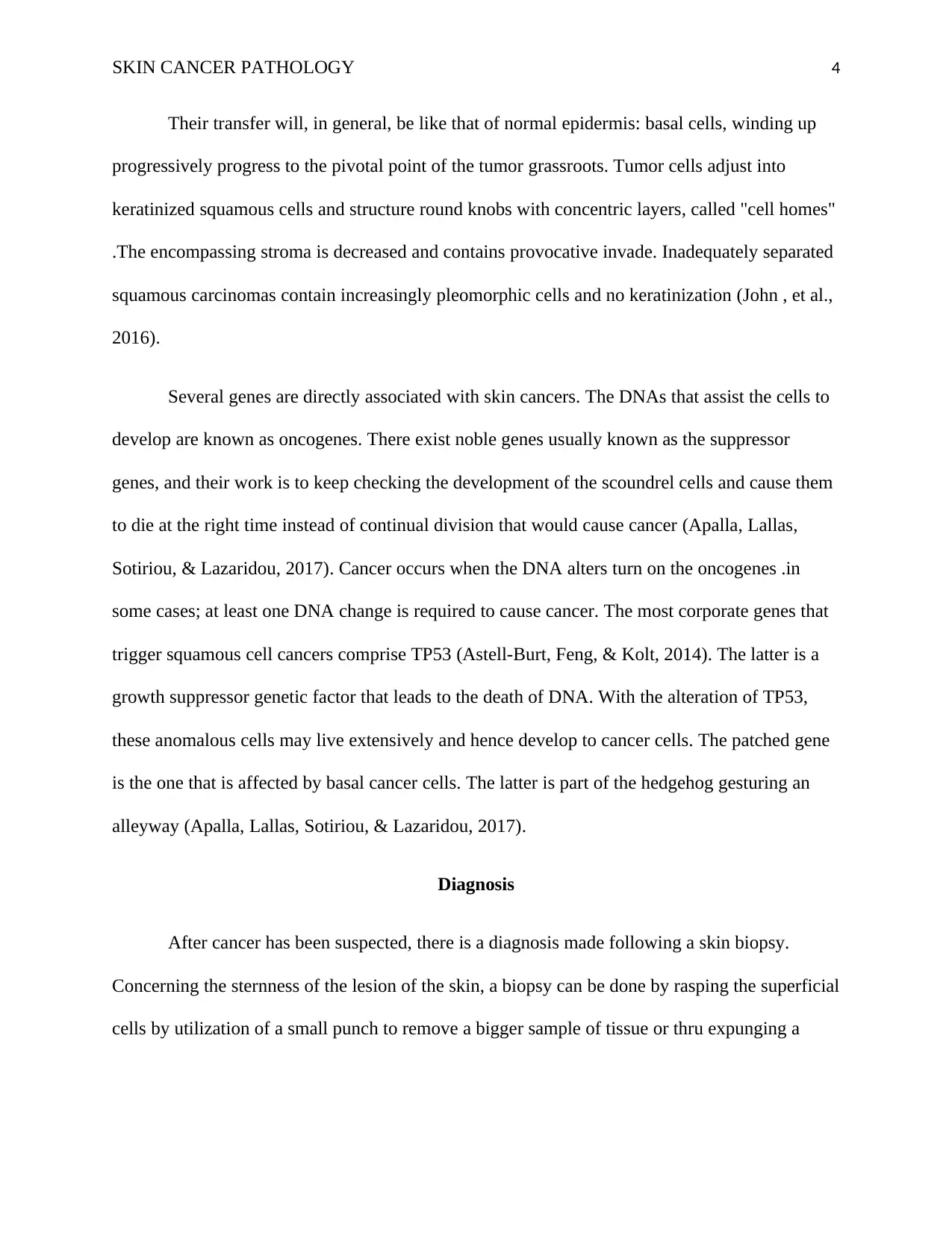
SKIN CANCER PATHOLOGY 4
Their transfer will, in general, be like that of normal epidermis: basal cells, winding up
progressively progress to the pivotal point of the tumor grassroots. Tumor cells adjust into
keratinized squamous cells and structure round knobs with concentric layers, called "cell homes"
.The encompassing stroma is decreased and contains provocative invade. Inadequately separated
squamous carcinomas contain increasingly pleomorphic cells and no keratinization (John , et al.,
2016).
Several genes are directly associated with skin cancers. The DNAs that assist the cells to
develop are known as oncogenes. There exist noble genes usually known as the suppressor
genes, and their work is to keep checking the development of the scoundrel cells and cause them
to die at the right time instead of continual division that would cause cancer (Apalla, Lallas,
Sotiriou, & Lazaridou, 2017). Cancer occurs when the DNA alters turn on the oncogenes .in
some cases; at least one DNA change is required to cause cancer. The most corporate genes that
trigger squamous cell cancers comprise TP53 (Astell-Burt, Feng, & Kolt, 2014). The latter is a
growth suppressor genetic factor that leads to the death of DNA. With the alteration of TP53,
these anomalous cells may live extensively and hence develop to cancer cells. The patched gene
is the one that is affected by basal cancer cells. The latter is part of the hedgehog gesturing an
alleyway (Apalla, Lallas, Sotiriou, & Lazaridou, 2017).
Diagnosis
After cancer has been suspected, there is a diagnosis made following a skin biopsy.
Concerning the sternness of the lesion of the skin, a biopsy can be done by rasping the superficial
cells by utilization of a small punch to remove a bigger sample of tissue or thru expunging a
Their transfer will, in general, be like that of normal epidermis: basal cells, winding up
progressively progress to the pivotal point of the tumor grassroots. Tumor cells adjust into
keratinized squamous cells and structure round knobs with concentric layers, called "cell homes"
.The encompassing stroma is decreased and contains provocative invade. Inadequately separated
squamous carcinomas contain increasingly pleomorphic cells and no keratinization (John , et al.,
2016).
Several genes are directly associated with skin cancers. The DNAs that assist the cells to
develop are known as oncogenes. There exist noble genes usually known as the suppressor
genes, and their work is to keep checking the development of the scoundrel cells and cause them
to die at the right time instead of continual division that would cause cancer (Apalla, Lallas,
Sotiriou, & Lazaridou, 2017). Cancer occurs when the DNA alters turn on the oncogenes .in
some cases; at least one DNA change is required to cause cancer. The most corporate genes that
trigger squamous cell cancers comprise TP53 (Astell-Burt, Feng, & Kolt, 2014). The latter is a
growth suppressor genetic factor that leads to the death of DNA. With the alteration of TP53,
these anomalous cells may live extensively and hence develop to cancer cells. The patched gene
is the one that is affected by basal cancer cells. The latter is part of the hedgehog gesturing an
alleyway (Apalla, Lallas, Sotiriou, & Lazaridou, 2017).
Diagnosis
After cancer has been suspected, there is a diagnosis made following a skin biopsy.
Concerning the sternness of the lesion of the skin, a biopsy can be done by rasping the superficial
cells by utilization of a small punch to remove a bigger sample of tissue or thru expunging a
Paraphrase This Document
Need a fresh take? Get an instant paraphrase of this document with our AI Paraphraser
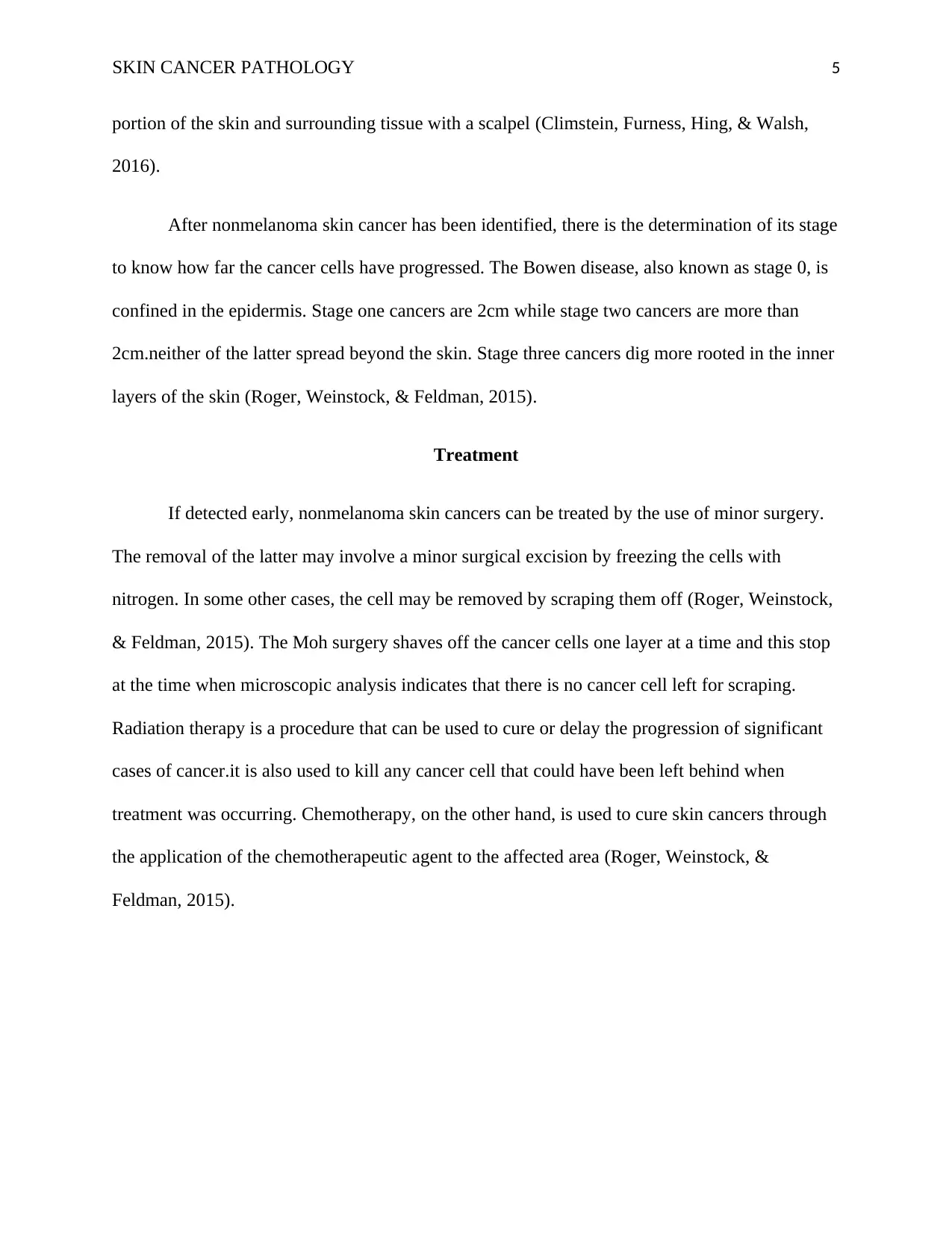
SKIN CANCER PATHOLOGY 5
portion of the skin and surrounding tissue with a scalpel (Climstein, Furness, Hing, & Walsh,
2016).
After nonmelanoma skin cancer has been identified, there is the determination of its stage
to know how far the cancer cells have progressed. The Bowen disease, also known as stage 0, is
confined in the epidermis. Stage one cancers are 2cm while stage two cancers are more than
2cm.neither of the latter spread beyond the skin. Stage three cancers dig more rooted in the inner
layers of the skin (Roger, Weinstock, & Feldman, 2015).
Treatment
If detected early, nonmelanoma skin cancers can be treated by the use of minor surgery.
The removal of the latter may involve a minor surgical excision by freezing the cells with
nitrogen. In some other cases, the cell may be removed by scraping them off (Roger, Weinstock,
& Feldman, 2015). The Moh surgery shaves off the cancer cells one layer at a time and this stop
at the time when microscopic analysis indicates that there is no cancer cell left for scraping.
Radiation therapy is a procedure that can be used to cure or delay the progression of significant
cases of cancer.it is also used to kill any cancer cell that could have been left behind when
treatment was occurring. Chemotherapy, on the other hand, is used to cure skin cancers through
the application of the chemotherapeutic agent to the affected area (Roger, Weinstock, &
Feldman, 2015).
portion of the skin and surrounding tissue with a scalpel (Climstein, Furness, Hing, & Walsh,
2016).
After nonmelanoma skin cancer has been identified, there is the determination of its stage
to know how far the cancer cells have progressed. The Bowen disease, also known as stage 0, is
confined in the epidermis. Stage one cancers are 2cm while stage two cancers are more than
2cm.neither of the latter spread beyond the skin. Stage three cancers dig more rooted in the inner
layers of the skin (Roger, Weinstock, & Feldman, 2015).
Treatment
If detected early, nonmelanoma skin cancers can be treated by the use of minor surgery.
The removal of the latter may involve a minor surgical excision by freezing the cells with
nitrogen. In some other cases, the cell may be removed by scraping them off (Roger, Weinstock,
& Feldman, 2015). The Moh surgery shaves off the cancer cells one layer at a time and this stop
at the time when microscopic analysis indicates that there is no cancer cell left for scraping.
Radiation therapy is a procedure that can be used to cure or delay the progression of significant
cases of cancer.it is also used to kill any cancer cell that could have been left behind when
treatment was occurring. Chemotherapy, on the other hand, is used to cure skin cancers through
the application of the chemotherapeutic agent to the affected area (Roger, Weinstock, &
Feldman, 2015).
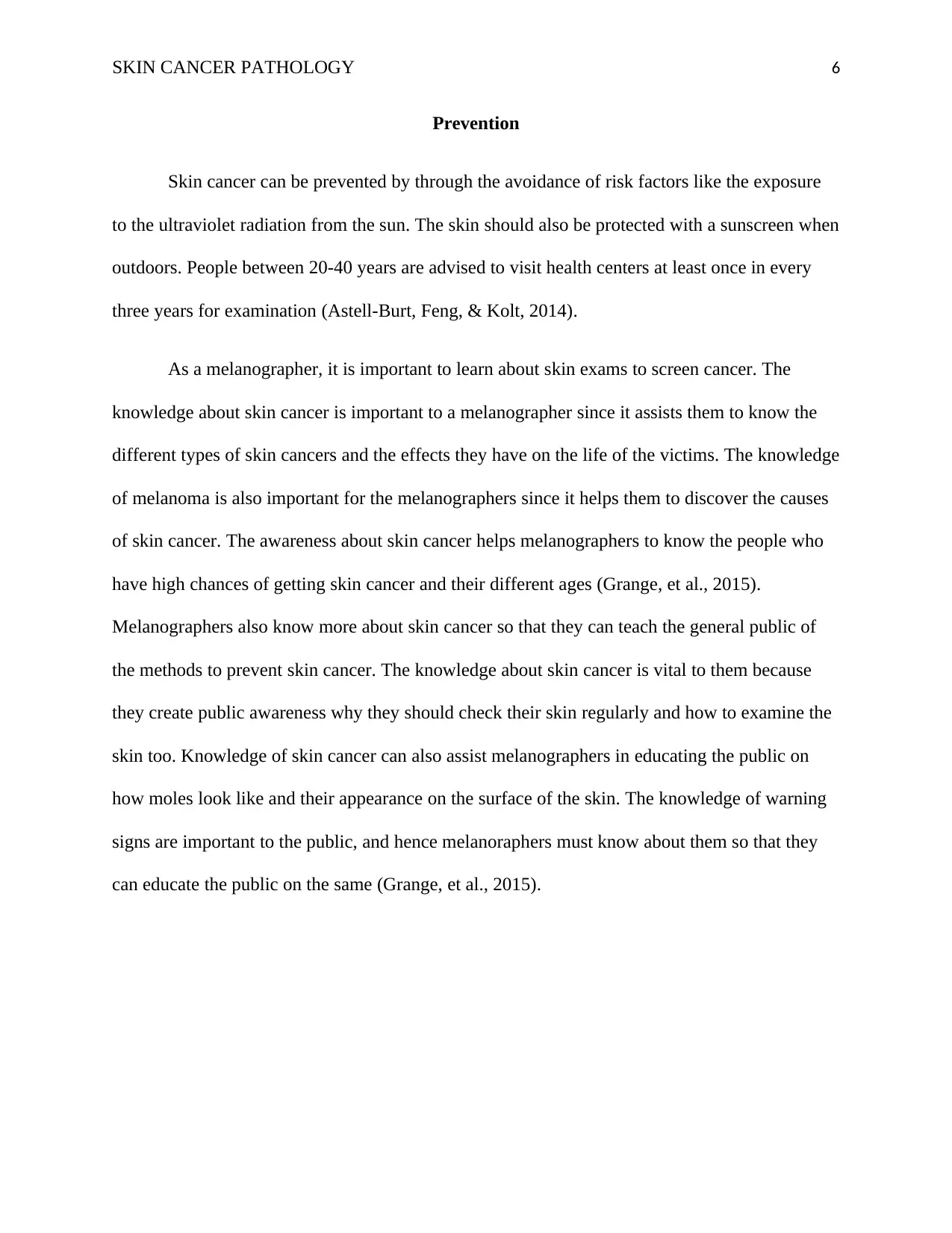
SKIN CANCER PATHOLOGY 6
Prevention
Skin cancer can be prevented by through the avoidance of risk factors like the exposure
to the ultraviolet radiation from the sun. The skin should also be protected with a sunscreen when
outdoors. People between 20-40 years are advised to visit health centers at least once in every
three years for examination (Astell-Burt, Feng, & Kolt, 2014).
As a melanographer, it is important to learn about skin exams to screen cancer. The
knowledge about skin cancer is important to a melanographer since it assists them to know the
different types of skin cancers and the effects they have on the life of the victims. The knowledge
of melanoma is also important for the melanographers since it helps them to discover the causes
of skin cancer. The awareness about skin cancer helps melanographers to know the people who
have high chances of getting skin cancer and their different ages (Grange, et al., 2015).
Melanographers also know more about skin cancer so that they can teach the general public of
the methods to prevent skin cancer. The knowledge about skin cancer is vital to them because
they create public awareness why they should check their skin regularly and how to examine the
skin too. Knowledge of skin cancer can also assist melanographers in educating the public on
how moles look like and their appearance on the surface of the skin. The knowledge of warning
signs are important to the public, and hence melanoraphers must know about them so that they
can educate the public on the same (Grange, et al., 2015).
Prevention
Skin cancer can be prevented by through the avoidance of risk factors like the exposure
to the ultraviolet radiation from the sun. The skin should also be protected with a sunscreen when
outdoors. People between 20-40 years are advised to visit health centers at least once in every
three years for examination (Astell-Burt, Feng, & Kolt, 2014).
As a melanographer, it is important to learn about skin exams to screen cancer. The
knowledge about skin cancer is important to a melanographer since it assists them to know the
different types of skin cancers and the effects they have on the life of the victims. The knowledge
of melanoma is also important for the melanographers since it helps them to discover the causes
of skin cancer. The awareness about skin cancer helps melanographers to know the people who
have high chances of getting skin cancer and their different ages (Grange, et al., 2015).
Melanographers also know more about skin cancer so that they can teach the general public of
the methods to prevent skin cancer. The knowledge about skin cancer is vital to them because
they create public awareness why they should check their skin regularly and how to examine the
skin too. Knowledge of skin cancer can also assist melanographers in educating the public on
how moles look like and their appearance on the surface of the skin. The knowledge of warning
signs are important to the public, and hence melanoraphers must know about them so that they
can educate the public on the same (Grange, et al., 2015).
⊘ This is a preview!⊘
Do you want full access?
Subscribe today to unlock all pages.

Trusted by 1+ million students worldwide
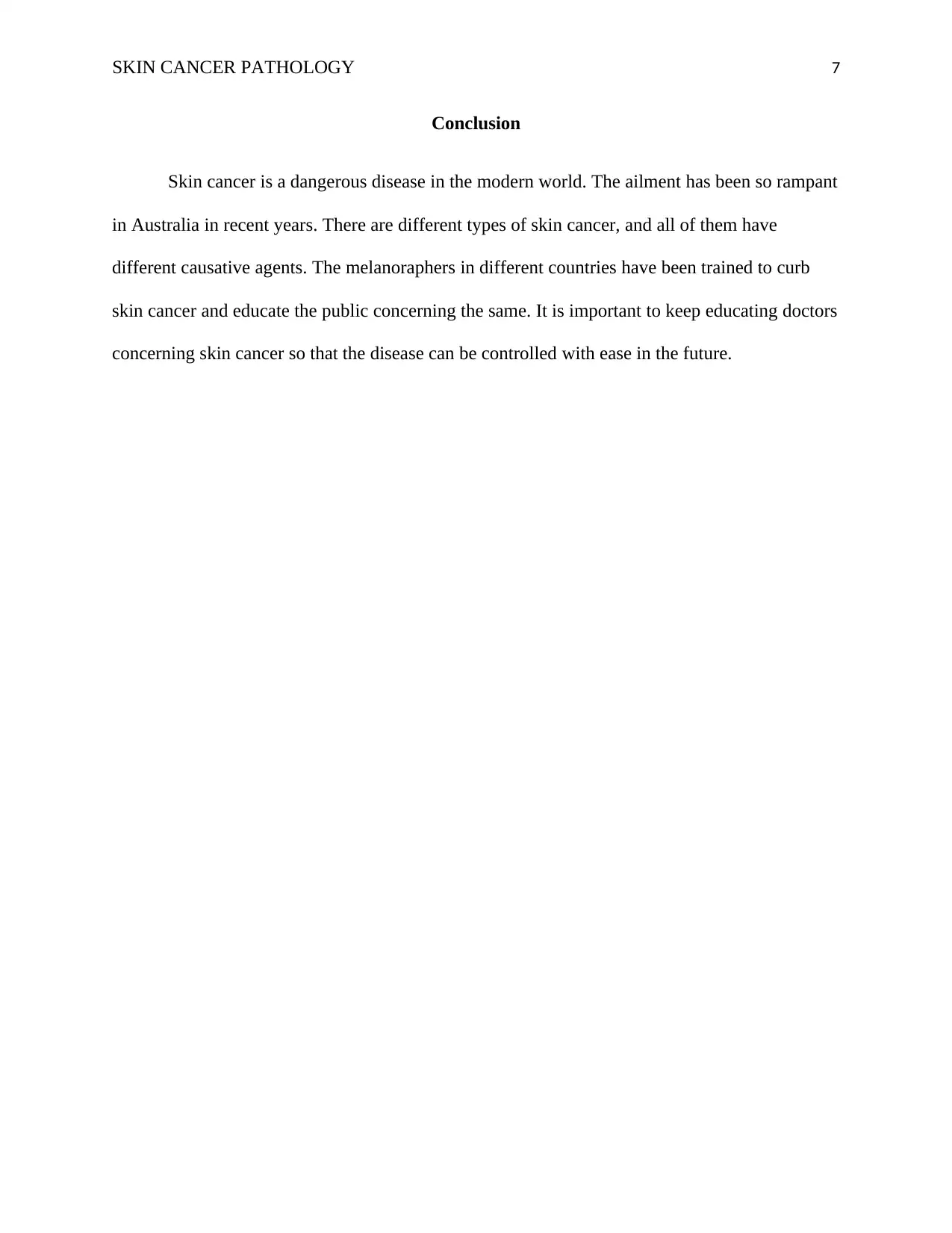
SKIN CANCER PATHOLOGY 7
Conclusion
Skin cancer is a dangerous disease in the modern world. The ailment has been so rampant
in Australia in recent years. There are different types of skin cancer, and all of them have
different causative agents. The melanoraphers in different countries have been trained to curb
skin cancer and educate the public concerning the same. It is important to keep educating doctors
concerning skin cancer so that the disease can be controlled with ease in the future.
Conclusion
Skin cancer is a dangerous disease in the modern world. The ailment has been so rampant
in Australia in recent years. There are different types of skin cancer, and all of them have
different causative agents. The melanoraphers in different countries have been trained to curb
skin cancer and educate the public concerning the same. It is important to keep educating doctors
concerning skin cancer so that the disease can be controlled with ease in the future.
Paraphrase This Document
Need a fresh take? Get an instant paraphrase of this document with our AI Paraphraser
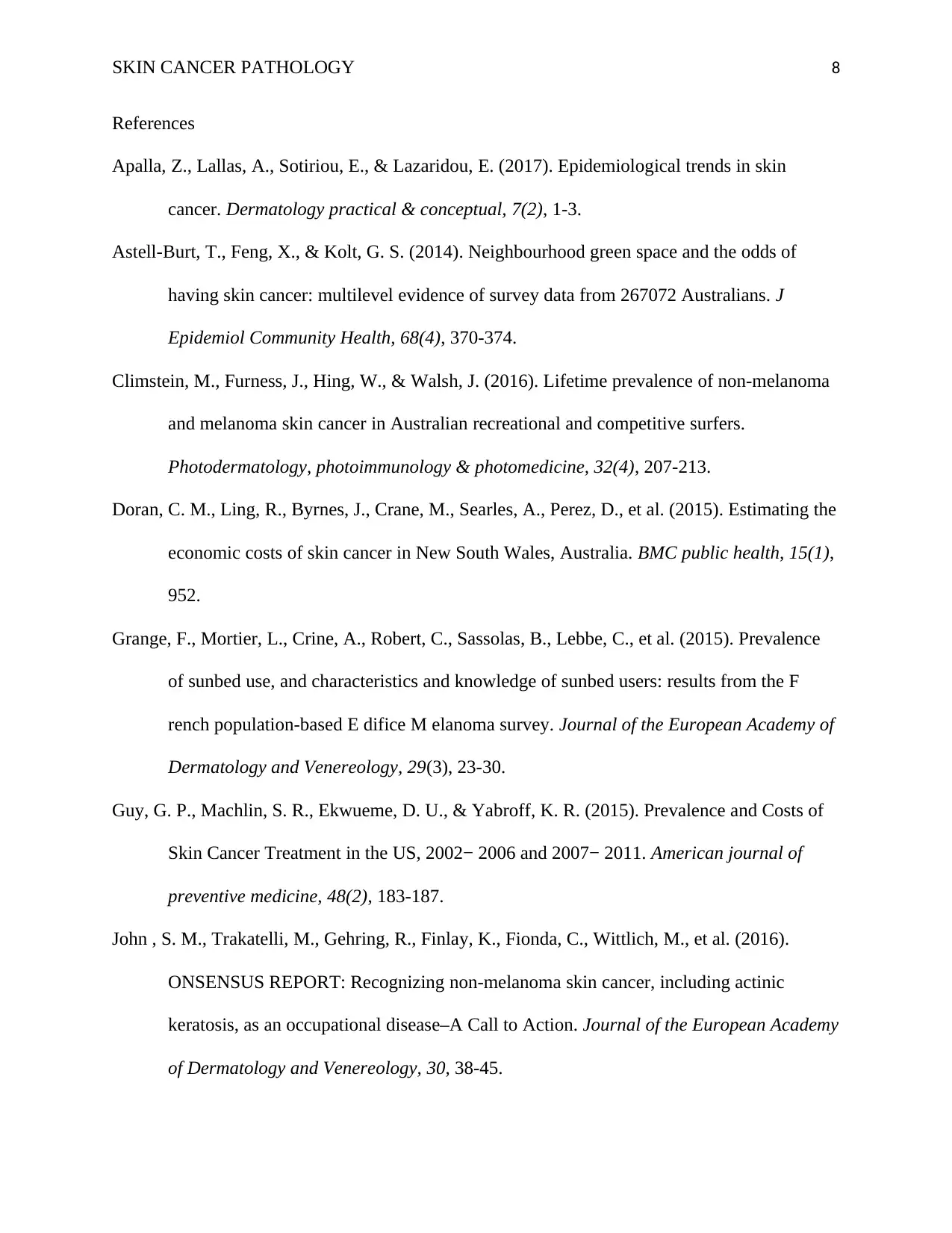
SKIN CANCER PATHOLOGY 8
References
Apalla, Z., Lallas, A., Sotiriou, E., & Lazaridou, E. (2017). Epidemiological trends in skin
cancer. Dermatology practical & conceptual, 7(2), 1-3.
Astell-Burt, T., Feng, X., & Kolt, G. S. (2014). Neighbourhood green space and the odds of
having skin cancer: multilevel evidence of survey data from 267072 Australians. J
Epidemiol Community Health, 68(4), 370-374.
Climstein, M., Furness, J., Hing, W., & Walsh, J. (2016). Lifetime prevalence of non‐melanoma
and melanoma skin cancer in Australian recreational and competitive surfers.
Photodermatology, photoimmunology & photomedicine, 32(4), 207-213.
Doran, C. M., Ling, R., Byrnes, J., Crane, M., Searles, A., Perez, D., et al. (2015). Estimating the
economic costs of skin cancer in New South Wales, Australia. BMC public health, 15(1),
952.
Grange, F., Mortier, L., Crine, A., Robert, C., Sassolas, B., Lebbe, C., et al. (2015). Prevalence
of sunbed use, and characteristics and knowledge of sunbed users: results from the F
rench population‐based E difice M elanoma survey. Journal of the European Academy of
Dermatology and Venereology, 29(3), 23-30.
Guy, G. P., Machlin, S. R., Ekwueme, D. U., & Yabroff, K. R. (2015). Prevalence and Costs of
Skin Cancer Treatment in the US, 2002− 2006 and 2007− 2011. American journal of
preventive medicine, 48(2), 183-187.
John , S. M., Trakatelli, M., Gehring, R., Finlay, K., Fionda, C., Wittlich, M., et al. (2016).
ONSENSUS REPORT: Recognizing non‐melanoma skin cancer, including actinic
keratosis, as an occupational disease–A Call to Action. Journal of the European Academy
of Dermatology and Venereology, 30, 38-45.
References
Apalla, Z., Lallas, A., Sotiriou, E., & Lazaridou, E. (2017). Epidemiological trends in skin
cancer. Dermatology practical & conceptual, 7(2), 1-3.
Astell-Burt, T., Feng, X., & Kolt, G. S. (2014). Neighbourhood green space and the odds of
having skin cancer: multilevel evidence of survey data from 267072 Australians. J
Epidemiol Community Health, 68(4), 370-374.
Climstein, M., Furness, J., Hing, W., & Walsh, J. (2016). Lifetime prevalence of non‐melanoma
and melanoma skin cancer in Australian recreational and competitive surfers.
Photodermatology, photoimmunology & photomedicine, 32(4), 207-213.
Doran, C. M., Ling, R., Byrnes, J., Crane, M., Searles, A., Perez, D., et al. (2015). Estimating the
economic costs of skin cancer in New South Wales, Australia. BMC public health, 15(1),
952.
Grange, F., Mortier, L., Crine, A., Robert, C., Sassolas, B., Lebbe, C., et al. (2015). Prevalence
of sunbed use, and characteristics and knowledge of sunbed users: results from the F
rench population‐based E difice M elanoma survey. Journal of the European Academy of
Dermatology and Venereology, 29(3), 23-30.
Guy, G. P., Machlin, S. R., Ekwueme, D. U., & Yabroff, K. R. (2015). Prevalence and Costs of
Skin Cancer Treatment in the US, 2002− 2006 and 2007− 2011. American journal of
preventive medicine, 48(2), 183-187.
John , S. M., Trakatelli, M., Gehring, R., Finlay, K., Fionda, C., Wittlich, M., et al. (2016).
ONSENSUS REPORT: Recognizing non‐melanoma skin cancer, including actinic
keratosis, as an occupational disease–A Call to Action. Journal of the European Academy
of Dermatology and Venereology, 30, 38-45.
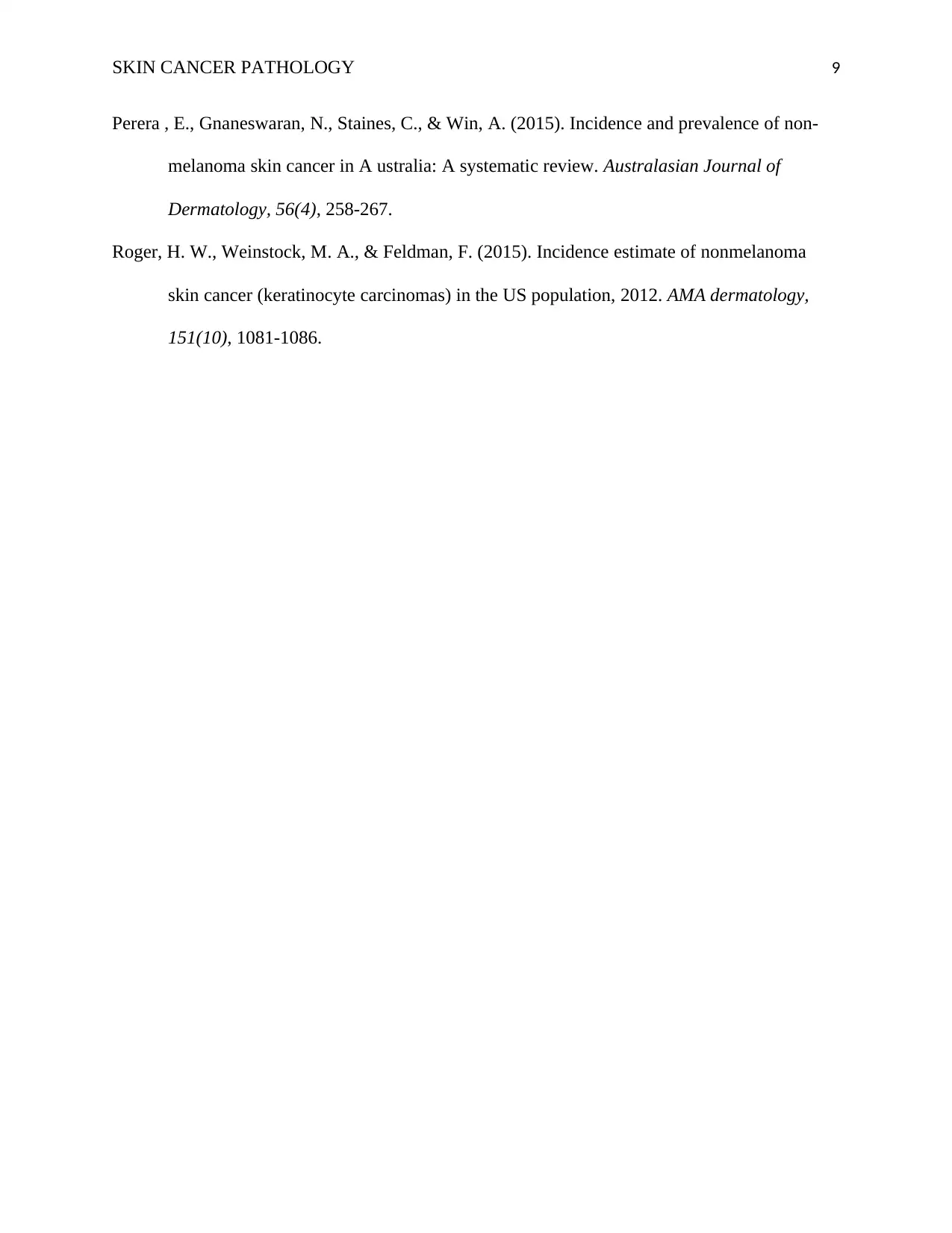
SKIN CANCER PATHOLOGY 9
Perera , E., Gnaneswaran, N., Staines, C., & Win, A. (2015). Incidence and prevalence of non‐
melanoma skin cancer in A ustralia: A systematic review. Australasian Journal of
Dermatology, 56(4), 258-267.
Roger, H. W., Weinstock, M. A., & Feldman, F. (2015). Incidence estimate of nonmelanoma
skin cancer (keratinocyte carcinomas) in the US population, 2012. AMA dermatology,
151(10), 1081-1086.
Perera , E., Gnaneswaran, N., Staines, C., & Win, A. (2015). Incidence and prevalence of non‐
melanoma skin cancer in A ustralia: A systematic review. Australasian Journal of
Dermatology, 56(4), 258-267.
Roger, H. W., Weinstock, M. A., & Feldman, F. (2015). Incidence estimate of nonmelanoma
skin cancer (keratinocyte carcinomas) in the US population, 2012. AMA dermatology,
151(10), 1081-1086.
⊘ This is a preview!⊘
Do you want full access?
Subscribe today to unlock all pages.

Trusted by 1+ million students worldwide
1 out of 9
Your All-in-One AI-Powered Toolkit for Academic Success.
+13062052269
info@desklib.com
Available 24*7 on WhatsApp / Email
![[object Object]](/_next/static/media/star-bottom.7253800d.svg)
Unlock your academic potential
Copyright © 2020–2025 A2Z Services. All Rights Reserved. Developed and managed by ZUCOL.


